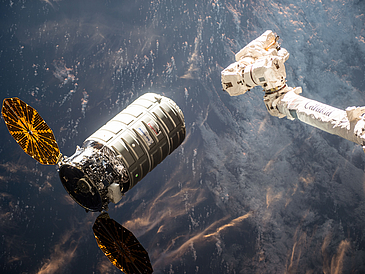In October 2016, the space transporter CYGNUS operated by the American firm Orbital ATK docked onto the ISS international space station. Part of the freight it was carrying was the international experimental setup called SAFFIRE II. The University of Bremen’s Center for Applied Aerospace Research and Microgravity (ZARM) contributed to the experiment with a large material sample.
New insights into fire behavior in space
SAFFIRE II is an experiment conceived by US-American, Russian, Japanese, and European scientists. They are attempting to gain better knowledge of the combustion behavior of solid materials under conditions of zero gravity. The task of the ZARM research team is connected with fire safety on manned space craft. Up to now, the testing and qualification of materials used in the construction of space craft has taken place exclusively in Earth-bound laboratories. These results, though, cannot be transferred 1:1 onto conditions prevailing in a space station in orbit. A fire breaking out on a space station would burn significantly less intensely than on Earth, but would generate much more heat. This is because under conditions of zero gravity there is no convection flow to carry the hot gases upwards and away from the seat of the fire. This means, for instance, that a burning substance in an Earth-bound laboratory may well burn itself out, whereas in a space station it would simply continue to burn for a much longer time.
The experiment and initial results
In the night of November 21, 2016, the space transporter carrying the SAFIRE II experimental setup was disconnected from the ISS. The experiment could begin. There was visible relief on the faces of observers at the Center for Applied Aerospace Research and Microgravity as the first images of a burning Perspex sample appeared on their screens. The experimental setup in space was working smoothly: The air stream had set in at the right moment: The hotwire had functioned and ignited the sample. When the ignition apparatus was switched off, the sample first continued to burn weakly before picking up again and turning to a fully fledged fire.
Initial evaluation
Initial evaluations carried out by the ZARM researchers reveal considerable differences compared with results obtained using the same material in lab experiments under terrestrial conditions. Whereas a fire on Earth burns with sharply contoured, high-contrast tongues of flame, the fire on SAFFIRE II looks as though being observed through a frosted glass screen – the flames lack structure, are not clearly defined, and “dance” more slowly. Soon, though, more important differences become visible: The fire on board CYGNUS spread 10 times more slowly than in Earth-bound lab experiments. Moreover, while burning Plexiglas on Earth tends not to produce heavy fumes, under conditions of zero gravity it is quite the opposite. However, this obviously safety-relevant aspect now complicates evaluation of SAFFIRE II. For, in contrast to Earth-bound experiments in which the rising flames obscure the lower layer zone of rising combustible pyrolysegases, flames under conditions of zero gravity not only burn much more slowly – they also spread out farther away from the flames.
This result represents an important step forward in understanding the behavior of fire in space: Because a fire in space spreads more slowly and exhibits a weaker turbulence – both effects caused by the lack of convection airflow in conditions of zero gravity – the area surrounding the material sample below and far-above the flames becomes considerably hotter than it would on Earth. This not only results in the fire penetrating deeper into the material, but the more intense heat can shift categorization of material properties from “self-extinguishing” to “combustible”. Thus, a fire like that in a space station would create more heat and burn more slowly.
The way the material sample in SAFFIRE II is deformed illustrates the effect of the stronger heat which was generated. The surface structures are more damaged than they would be in an Earth-bound experiment – even in areas farther away from the flames.
Happy faces in Bremen after the successful experiment
The ZARM research team were particularly pleased they were able to reach first assessments of the experiment after just a few hours had gone by. Nevertheless, they still have a lot to do evaluating the copious date produced by sensor measurements taken during the 11-minute experiment in space. Things like inflow air velocity and temperature, oxygen concentrations, pressure, air humidity, and radiation density – not to mention the 20,000 photos taken during the experiment. This will keep them busy for some time to come. Once everything is completed, though, the results will be published in a scientific study. They will then be used in the planning of the forthcoming SAFFIRE V experiment, which is expected to deliver more vital information leading to fire safety on manned space craft.
If you would like to have more information, feel free to contact:
Christian Eigenbrod
Head of the research group “Aerospace Combustion Engineering”
Center for Applied Aerospace Technology and Microgravitation, University of Bremen
christian.eigenbrodprotect me ?!zarm.uni-bremenprotect me ?!.de
Phone: +49 421 218-57780
Information for members of the press:
Center for Applied Aerospace Technology and Microgravitation, University of Bremen
Dr. Lucie-Patrizia Arndt
lucie-patrizia.arndtprotect me ?!zarm.uni-bremenprotect me ?!.de
Phone: +49 421 218-57817

